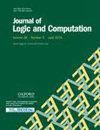Serial properties, selector proofs and the provability of consistency
IF 0.7
4区 数学
Q3 COMPUTER SCIENCE, THEORY & METHODS
引用次数: 0
Abstract
The consistency of a theory means that each of its formal derivations $D_{0}, D_{1}, D_{2}, \ldots $ is free of contradictions. For Peano Arithmetic PA, after the standard coding of derivations by numerals, PA-consistency is directly represented by the consistency scheme $\textsf{Con}^{S}_{\textsf{PA}}$, which is a series of arithmetical statements ‘$n$ is not a code of a derivation of $\ (0=1)$’ for numerals $n=0,1,2,\ldots $. We note that the consistency formula $\textsf{Con}_{\textsf{PA}}$, $\forall x$ ‘$x$ is not a code of a derivation of $(0=1)$,’ is strictly stronger in PA than PA-consistency and corresponds to some other property, which we call uniform consistency. When studying the provability of consistency in PA we ought to work not with the consistency formula $\textsf{Con}_{\textsf{PA}}$ but rather with the consistency scheme $\textsf{Con}^{S}_{\textsf{PA}}$, which adequately represents PA-consistency. This paper introduces the Hilbert-inspired notion of proof of an infinite series of formulas in a theory and proves PA-consistency in the form $\textsf{Con}^{S}_{\textsf{PA}}$ in PA. These findings show that PA proves its consistency whereas, by Gödel’s second incompleteness theorem, PA cannot prove its uniform consistency.序列属性、选择器证明和一致性的可证明性
一个理论的一致性意味着它的每一个形式推导 $D_{0}, D_{1}, D_{2}, \ldots $ 都没有矛盾。对于皮亚诺算术 PA,在用数字对导数进行标准编码之后,PA-一致性直接由一致性方案 $\textsf{Con}^{S}_{\textsf{PA}}$来表示,它是一系列针对数字 $n=0,1,2,\ldots$的算术声明'$n$不是 $\ (0=1)$ 的导数的编码'。我们注意到一致性公式$\textsf{Con}_{\textsf{PA}}$, $\forall x$ '$x$不是$(0=1)$的派生代码',在PA中严格强于PA-一致性,并且对应于另一些性质,我们称之为统一一致性。在研究 PA 中一致性的可证明性时,我们不应使用一致性公式 $\textsf{Con}_{textsf{PA}}$ ,而应使用一致性方案 $\textsf{Con}^{S}_{\textsf{PA}}$ ,它充分代表了 PA 一致性。本文引入了希尔伯特启发的理论中无穷序列公式的证明概念,并证明了 PA 中 $\textsf{Con}^{S}_{\textsf{PA}}$ 形式的 PA 一致性。这些发现表明 PA 证明了其一致性,而根据哥德尔第二不完备性定理,PA 无法证明其统一一致性。
本文章由计算机程序翻译,如有差异,请以英文原文为准。
求助全文
约1分钟内获得全文
求助全文
来源期刊

Journal of Logic and Computation
工程技术-计算机:理论方法
CiteScore
1.90
自引率
14.30%
发文量
82
审稿时长
6-12 weeks
期刊介绍:
Logic has found application in virtually all aspects of Information Technology, from software engineering and hardware to programming and artificial intelligence. Indeed, logic, artificial intelligence and theoretical computing are influencing each other to the extent that a new interdisciplinary area of Logic and Computation is emerging.
The Journal of Logic and Computation aims to promote the growth of logic and computing, including, among others, the following areas of interest: Logical Systems, such as classical and non-classical logic, constructive logic, categorical logic, modal logic, type theory, feasible maths.... Logical issues in logic programming, knowledge-based systems and automated reasoning; logical issues in knowledge representation, such as non-monotonic reasoning and systems of knowledge and belief; logics and semantics of programming; specification and verification of programs and systems; applications of logic in hardware and VLSI, natural language, concurrent computation, planning, and databases. The bulk of the content is technical scientific papers, although letters, reviews, and discussions, as well as relevant conference reviews, are included.
 求助内容:
求助内容: 应助结果提醒方式:
应助结果提醒方式:


